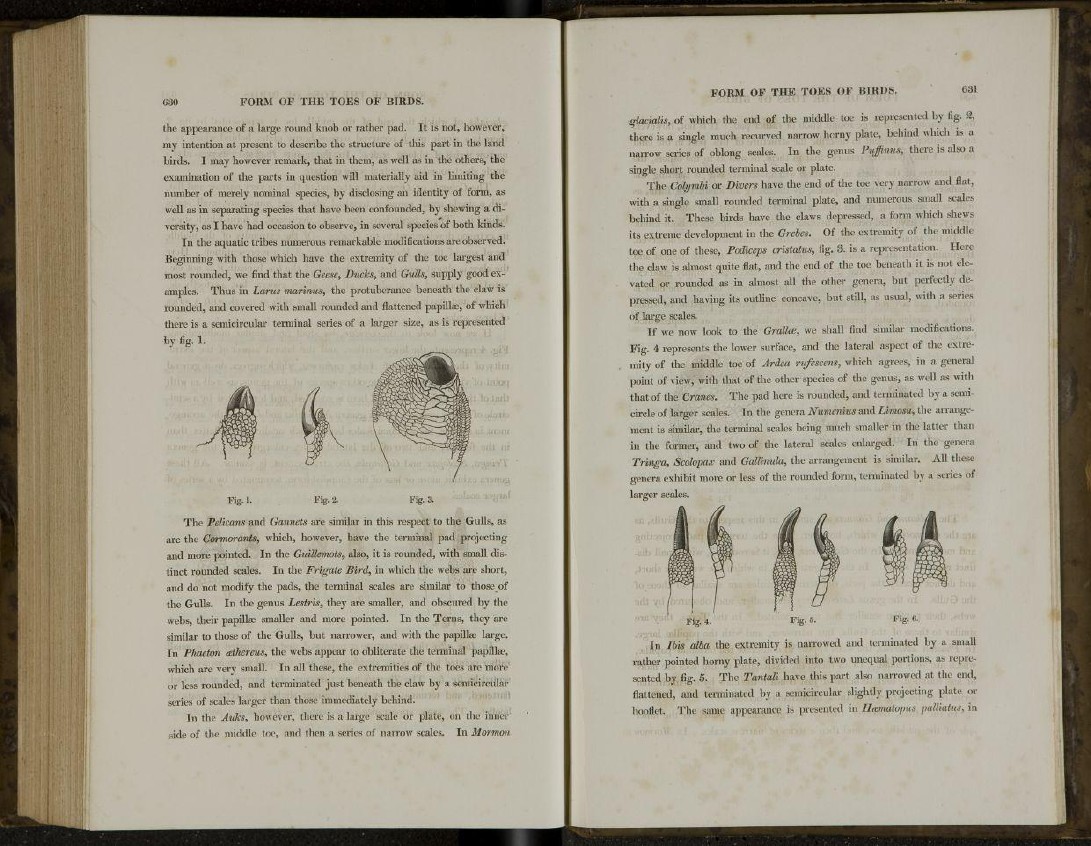
630 FORM OF THE TOES OF BIRDS.
the appearance of a large round knob or rather pad. It is not, however,
my intention at present to describe the structure of this part in the land
birds. I may however remark, that in them, as well as in the others, the
examination of the parts in question will materially aid in limiting the
number of merely nominal species, by disclosing an identity of form, as
well as in separating species that have been confounded, by shewing a diversity,
as I have had occasion to observe, in several species of both kinds.
In the aquatic tribes numerous remarkable modifications are observed.
Beginning with those which have the extremity of the toe largest and
most rounded, we find that the Geese, Ducks, and Gulls, supply good examples.
Thus in Larus marinus, the protuberance beneath the claw is
rounded, and covered with small rounded and flattened papilla?, of which
there is a semicircular terminal series of a larger size, as is represented
Fig. 1. Fig. 2. Fig. 3.
The Pelicans and Gannets are similar in this respect to the Gulls, as
are the Cormorants, which, however, have the terminal pad projecting
and more pointed. In the Guillemots, also, it is rounded, with small distinct
rounded scales. In the Frigate Bird, in which the webs arc short,
and do not modify the pads, the terminal scales are similar to those of
the Gulls. In the genus Lestris, they are smaller, and obscured by the
webs, their papilla? smaller and more pointed. In the Terns, they are
similar to those of the Gulls, but narrower, and with the papilla? large.
In Phaeton eethereus, the webs appear to obliterate the terminal papilla1,
which are very small. In all these, the extremities of the toes arc more
or less rounded, and terminated just beneath the claw by a semicircular
series of scales larger than those immediately behind.
In the Auks, however, there is a large scale or plate, on the inner
ade of the middle toe, and then a series of narrow scales. In Mormon
FORM OF THE TOES OF BIRDS. 631
glacialis, of which the end of the middle toe is represented by fig. 2,
there is a single much recurved narrow horny plate, behind which is a
narrow series of oblong scales. In the genus Puffinus, there is also a
single short rounded terminal scale or plate.
The Colymbi or Divers have the end of the toe very narrow and flat,
with a single small rounded terminal plate, and numerous small scales
behind it. These birds have the claws depressed, a form which shews
its extreme development in the Grebes. Of the extremity of the middle
toe of one of these, Podiceps cristatus, fig. 3. is a representation. Here
the claw is almost quite flat, and the end of the toe beneath it is not elevated
or rounded as in almost all the other genera, but perfectly depressed,
and having its outline concave, but still, as usual, with a series
of large scales.
If we now look to the Grallce, we shall find similar modifications.
Fig. 4 represents the lower surface, and the lateral aspect of the extremity
of the middle toe of Ardea ntfescens, which agrees, in a general
point of view, with that of the other species of the genus, as well as with
that of the Cranes. The pad here is rounded, and terminated by a semicircle
of larger scales. In the genera Numenius and Limosa, the arrangement
is similar, the terminal scales being much smaller in the latter than
in the former, and two of the lateral scales enlarged. In the genera
Tringa, Scolopax and Gallinula, the arrangement is similar. All these
genera exhibit more or less of the rounded form, terminated by a series of
larger scales.
Fig. 4 . Fig. 5. Fig. 6.
In Ibis alba the extremity is narrowed and terminated by a small
rather pointed horny plate, divided into two unequal portions, as represented
by fig. 5. The Tantali have this part also narrowed at the end,
flattened, and terminated by a semicircular slightly projecting plate or
hooflet. The same appearance is presented in Hfematopus palliatus, in